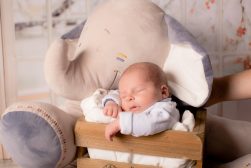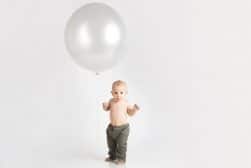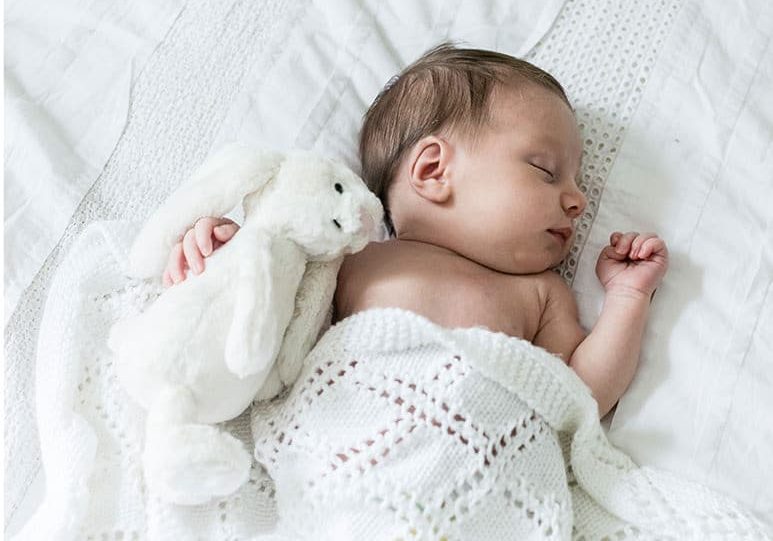
17 Newborn Photography Tips For Creative Results in 2024
Find out the best newborn photography tips and ideas in this must-read guide! Learn how to get started or take your baby shots to the next level.
Learn | Maternity Photography | By Louise Downham | Last Updated: January 2, 2024
Newborn photography is a type of family photography dedicated to capturing the arrival of a new member. It’s one of the most important and happiest events in life, and that’s why everyone wants professional images to immortalize it.
It is, however, one of the most delicate matters to approach because it’s so intimate. That’s why it’s important that you and your client are prepared.
One of the key aspects of your job is to provide all the information on what they should expect. Help them decide on a location and provide some tips on when to do it.
To be able to help them and deliver high-quality images, you need to be confident and informed.
In this article, you’ll find all the information you need to plan and perform the baby photoshoot. You’ll also find some newborn photography tips from a professional to get you ready and inspired.
But first things first, you need to decide which area you want to specialize in when photographing newborns.
Let’s get started!
What are the Types of Newborn Photography?
Newborn photography (also known as a Fresh 48 photo session) is a growing business and has many areas that you can cover. It all depends on your interests, your skills, and your personal approach.
Before I show you how to take photos of babies, here are the four main types of creative newborn photography.
- Birth Photography – this is the most literal meaning of newborn photography. More and more couples are hiring professionals to photograph the moment of birth. This is followed by doing high-quality images of the precious bonding moments right after the newborn baby comes into this world.
- Lifestyle – Normally, these types of newborn photography sessions happen at the client’s home or on location; this depends on your style. Most of the time it’s done with natural light, although you can bring some fill lights if the house isn’t particularly bright. Lifestyle shots feature casual scenes, and they can include pets or siblings and the newborn baby.
- Studio Portraits – this can happen in the studio, or at their house but treated as a studio for portrait photography. The newborn baby is posed, and you use props, costumes and decorations for the scene. It’s a style of photo that can be very simple, i.e. the baby swaddled in a seamless background; or an elaborate set can be created, for example, for seasonal images.
- Creative Composites – this is a sub-genre of the posed portrait photos. You’ve probably seen baby photos featuring poses of a levitating child surrounded by flying toys. Needless to say that those are digital composites, and you need to set the poses and capture the photographs specifically for this purpose. It will involve newborn posing to position the baby’s head, arms and keep the baby’s legs tucked in position.
- Home (DIY) newborn photography – this is where you attempt to take photos of your newborn baby yourself.
What Do I Need for a Newborn Photo Shoot?

Credit: Elli Cassidy
To capture the best photo possible during your newborn photography session, you need to be prepared and properly equipped with all the camera gear, lenses and newborn props.
I’ll show you everything you need to build your own newborn photography kit.
Setting up a newborn session quickly is essential when photographing newborns. The windows of opportunity will be short as all too often the baby decides on the schedule. It can take some time just to get the poses right for the baby photo you desire.
If you want to be able to control your light, then you can’t just rely on ambient light, because newborn photography sessions can tend to take longer than expected.
It’s useful to have as much information as possible about the client’s expectation and the place where you’ll be working to understand what you’ll need. First, let’s talk about camera gear:
- Camera
In general, every camera that has a manual mode and allows for different lenses can work for a baby photo. A camera for newborn photography that only has an auto mode might limit how creative you can be with the outcomes.
It also impacts your ability to control exposure, depth of field and image quality.
A camera that allows for interchangeable lenses is best as it provides greater flexibility with the styles of photos you capture.
A camera with a fixed lens will typically be a wide-angle view – not ideal for newborn photography as you need to get in close without distorting the image.
However, mirrorless cameras have the advantage of being totally silent. Mirrorless cameras feature an electronic shutter (in addition to a mechanical shutter that is noisy).
With the electronic shutter, you can set the camera for silent shooting where the entire operation is completely silent. Silent shooting won’t startle or distract the baby as a mechanical shutter will.
How Much Do You REALLY Know About Photography?! 🤔
Test your photography knowledge with this quick quiz!
See how much you really know about photography...

If you work under low light conditions, a full-frame camera will give you better results because they create less image noise. Image noise is also caused by using too high an ISO.
In general, full-frame cameras handle this better as their sensors are suited to capturing as much light as possible.
The lenses you need can depend on the type of photography that you do and the availability of space.
If you have a range of lenses to choose from, always have a macro lens for photographing the details on those adorable baby fists and toes.
Macro lenses allow you to get in super close to the baby and still maintain correct focus. In fact, macro lenses with a longer focal range such as 85mm also make for great portrait lenses. They deliver sharp details and excellent image quality.
It is also worth having a range of focal lengths between 35mm and 85mm for baby images. Anything wider than 35mm can result in photos of your baby where the body is distorted.
The 35mm – 85mm focal range can be all in one zoom for versatility or a couple of prime lenses for sharper images and bigger apertures.
Speaking of apertures, the wider the aperture a lens has the better for newborn baby photos. With an f/1.4 or f/2 aperture, you’ll gain a sharp focus on facial features while the background elements fall into soft focus.
(This is referred to as a shallow depth of field and creates a stunning baby photo.)
In short, the best lens for baby photography is actually a combination of lenses with fast apertures and focal ranges in the wide angle to normal range.
- Lights
Set up the first newborn shoot in a location with plenty of natural window light. This is a good rule to apply with any family photos to make the most of the constant light.
While natural light is the most common, sometimes it just isn’t enough. Sometimes the baby’s routine doesn’t match the perfect timing of light streaming in through the living room window.
If you’re facing this situation, bring some low power strobes or some continuous light to avoid using any flash that could hurt their sensitive eyes.
Always avoid direct flash and where possible place your flash units away from the camera on light stands.
- Light Modifiers
You should avoid firing any bright lights – especially directly at the baby. If you really need to use a strobe or flash, it’s best if you soften the light with a modifier.
You can use a range of light modifiers such as softboxes, umbrellas, or any other modifier to capture a correctly exposed newborn photo.
A light modifier such as a softbox allows you to mount the flash or strobe inside. Thanks to the opaque filtering fabric, any light is diffused and less harsh as it falls on the posing baby.
What’s more, a softbox prevents harsh shadows from being cast around the baby as a direct flash would. Using a light modifier to capture a baby photo creates far more natural and appealing photos that display the softness of the newborn.
The best newborn photography still follows the classic rules for taking great pictures. You should have some basic light modifiers on hand to take control of unruly natural lighting.
Sometimes it’s easy to get carried away and try to capture the perfect expression, yawn or frown. As a result, you can chew through your memory card storage space quite quickly.
Some mirrorless and DSLR cameras can accommodate high capacity cards and even dual SD cards. In any event, make sure you have plenty of memory for those creative newborn photos!
Regardless, it’s always good to have two or three on hand in preparation for a baby photo session. The last thing you want is a perfect opportunity with a calm baby only to realise that you can’t take more photos due to a full memory card.
- Backdrops
These are essential for studio portraits to capture photos where the baby is the centre of attention and not the cluttered background.
Backdrops are available in different colors or patterns to make your subject stand out in a newborn photo, or you can even make your own.
To support backdrops, special frames are available that allow the backdrop to fall evenly and not buckle. Alternatively, consider hanging backdrops from curtain rails and high furniture if shooting in the home.
If the backdrop and support are top-heavy, make sure to weigh it down so it doesn’t accidentally topple and hurt the baby. Having the best newborn baby photoshoot means keeping safety priority number one!
- Clamps
Always pack some clamps in your photographic bag. They can be useful to position the backdrop, hold some of the props or secure everything in the set to avoid accidents.
If you’re taking baby photos in the family home, clamps are handy to attach backdrops to curtain rails and or to a doorframe.
Clamps are available in a range of sizes with those that use spring-loaded pressure and others that wind down for added security.
- A-Ladder or Steps
Photographing from the top down is a great angle for baby and newborn photography. To do this, you have to be higher up, but you don’t want to be endangering anyone’s life. So, you’ll need something stable to work with.
If you have a photography studio, having a step ladder and a tall ladder are essential items. If you are working from other people’s homes, keep a two or three-step ladder in your car.
Ensure you use one that has rubber feet so it won’t slip or damage the family’s floor.
While photographic equipment and tools are essential to the photoshoot, the props and baby-related items are just as important for successful images.
Here’s a quick checklist that you can use.
- Wet wipes
Now I want to cover some newborn photography essentials that other photographers might have never had to bring to a shoot before!
These will come in handy for all kinds of accidents – trust me, you won’t regret having them.
- Soothing Noise/Music
You want the child to be calm, happy, and preferably asleep. It will help a lot when poising the baby for the photo.
A white noise machine, a playlist with classical music, or any kind of sound that creates a relaxing atmosphere is useful.
The best tool for this is a portable Bluetooth speaker that pairs with your smartphone. There are even white noise apps available that play children’s soothing music and sounds.
All of my tips for newborn photography come down to this: A happy baby means you get to snap the best baby photos!
See also: tips for photographing toddlers.
- Pillows
One or two pillows are always helpful to position your subject while keeping them comfy and safe. Pillows also help with supporting the baby’s head when styling newborn poses.
Another option is to use a bean bag for comfortable posing. Bean bags are great as they can be moulded into the desired shape while still keeping the baby in its pose. If you don’t have a nice enough bean bag, drape blankets over it.
- Blankets
All sorts of blankets and swaddles will come in handy in your photoshoots. Blankets will keep the infant warm and comfortable while making a perfect prop to add a touch of color or some texture.
If working in a cold space, it’s a great idea to set up a space heater well before the photo shoot. Textured blankets also make for interesting backdrops in a newborn photo shoot.
- Rattles
Not all baby photos feature a pose with a sleeping baby. Sometimes it is nice to have them awake and looking at the camera. The best way to grab the attention of a baby is by using noise and colorful toys, for example, rattles.
Toys also help you capture more interesting newborn pics. You can get action shots of the infant reaching for a toy, reacting to a rattle, or puzzling the mysteries of the universe while you grab their attention with a rattle.
Without adorable props, you can end up with monotonous baby images if you’re not creative and well prepared. Bring with you all sorts of baby toys and decorations to fill the frame and make an interesting composition.
Props, backdrops, and even toys can all give you new born picture ideas.
This will also help you to create your own style, just make sure that everything is safe to use and they suit the style of pose you envision. Larger props that you can sit the baby in are especially handy for posing newborns during studio sessions.
17 Newborn Photography Tips
These photography tips are by award-winning family portrait and newborn photographer Louise Downham.
They relate to preparatory tips for yourself, and your clients, as well as tips for the day of the newborn photography session.
As with any type of portrait photography, the most important element is preparation – feeling comfortable with your game plan and with your clients will go a long way to making sure you capture those precious moments beautifully.
Here’s a few baby photography tips you can’t go without!
1. Shot List

Credit: Pixabay
Have in mind a loose shot list of the photographs you plan to take. Will you approach the newborn portrait as a lifestyle session, or will you give the clients some guidance and suggest certain poses or set-ups?
Are you planning to photograph mom and dad as well as the newborn, and any siblings, like in a family portraits series? Will there be any other relatives present at the newborn session – grandparents are often in the wings, for example.
Gather all the information you can to prepare the right shot list. Having at least a rough shot list will help make sure you get the best newborn photos.
2. Make Yourself Comfortable
You’ll likely end up in all sorts of strange positions getting just the right angle for a tiny newborn, so wear clothing that you’ll feel comfortable moving around in and stretching.
If you’re worried about what to wear for newborn photos, just remember to keep it comfortable and professional and you’ll be fine.
If you have a camera with a tilting LCD screen, you’ll be able to get creative with your compositions more easily.
3. Stay Hydrated
New parents can be completely consumed with amazement at their newborn – you may not be offered a drink for hours! Take a bottle of water with you just in case your concentration levels will start to dip if you get thirsty.
While I’m on the subject, babies aren’t the only ones who can benefit from a little snack time! Your new born baby pics will improve if you have a few snacks to keep you going throughout a long shoot.
4. Cover the Essentials
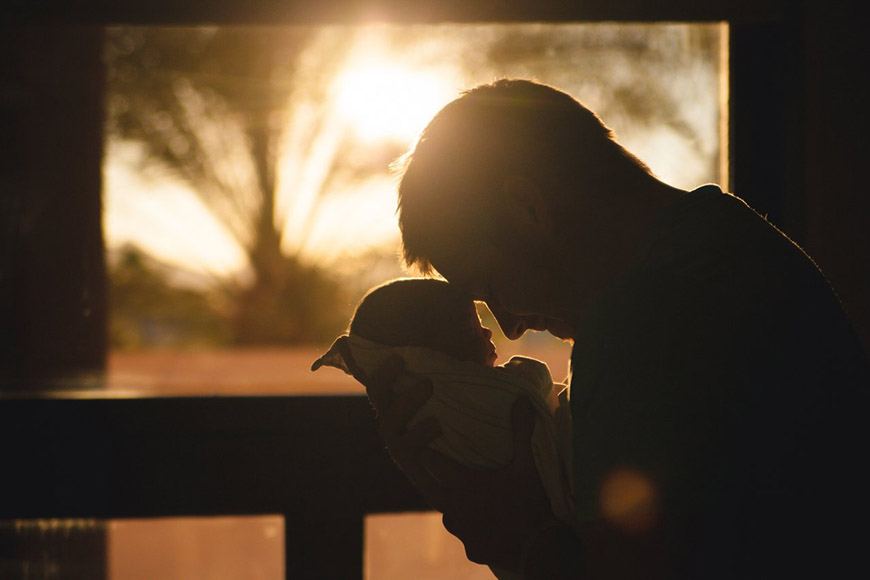
Credit: Josh Willink
Is there anything that mom and dad are particularly looking for from their newborn portraits? Have they seen any photographs that they particularly liked?
Clients vary wildly as to whether they’d like more photographs of them all together as a new family, or mostly photographs of their newborn – some parents don’t even want to be photographed at all.
I encourage families to feature in one way or another, even if it’s just their arms being in shot holding the little one. When that little child is an adult, it’ll mean so much to them to have photographs that also shows the people and environment that welcomed them into the world.
Send an email summing up what you’ve discussed and decided, this way all parties involved are clear on what is going to happen and what they need to do.
5. The Age of the Newborn Is Important
Consider how old the newborn will be at the time of the portrait photoshoot. Newborn photographers that work in the studio often want to do the shoot in the first week, but for home sessions, the first two weeks are generally fine.
Bear in mind the hormone crash that mums will go through on day 4 or 5 after the birth, and the fact that newborns will often suffer from baby acne and digestive issues from week 2 for a couple of weeks, and will often launch into cluster feeding from days 11 onward as they prepare for a growth spurt.
I prefer to photograph newborns 7 to 10 days after they’re born when they had a chance to get back from the hospital and settle into their new life but the infant is still definitely in the newborn stage.
6. Plan the Parents’ Clothes Too

Credit: Danijel Durkovic
Make some suggestions as to what everyone might wear for the newborn photos. New mums might prefer a loose T-shirt as it’s more flattering for baby weight than tight breastfeeding tops – word this suggestion carefully though, as no one’s more sensitive than a new mum!
I always ask for them to take their watches off beforehand, as it’s so distracting having a big watch in the shot if you go for a close-up of a newborn lying in the parents’ arms. You don’t want to do this at the moment as a watch will usually leave a mark for a good few minutes till the skin settles.
Make sure to have this fashion chat well before you start taking newborn baby portraits. This gives the parents time to plan their outfits rather than having them rush to change last minute!
7. Recommend the Best Time of Day
Ask the parents what time of day would suit their emerging routine best. Newborns tend to be happier in the morning, so that’s usually a good time for taking their photos.
Avoid their witching hour at all costs, towards the late afternoon – it can take hours to settle even the calmest newborn at the end of the day. Choosing to take family photos or posing a baby at that time is a special kind of madness.
Also consider your season. Fall newborn photos have a decidedly different look than winter or summer portraits.
8. Don’t Rush In

Credit: Garrett Jackson
Spend a few minutes chatting with the parents before you get started on the day, to help them relax and feel comfortable around you – calming any of their nerves will really help you take the best photographs.
Parents are protective of their children, so taking the time to be on their side is critical. Ask them questions about the temperament of the baby, what makes them laugh and if any kind of situations or behaviours upsets them.
Any portrait photographer should take a similar approach with models well before they ask for poses or take photos. One of the most important baby portrait photography tips is to work with your subject, not against them.
Newborn posing should never be rushed. When setting up for a newborn photo, you need to try different poses with the newborn’s head, hands and feet. But by far the most essential pro tip is to always support the baby’s head.
Support the baby’s head when lifting, moving and carrying the baby at all times – they don’t have the neck muscles yet to support it themselves.
9. Get Experience with Babies
Get some experience with newborns first before photographing one – they’re quite different from young babies, and need a lot more attention!
The best newborn baby photos are taken by people with great skills behind the camera and great skills when it comes to working with newborns.
If you’ve spent time around a newborn baby, the constant diaper changes and feeds won’t come as a surprise – and you won’t be panicking that all the time is being used up with bodily needs. You’ll have seen how there’s a window of calm after all the excitement – that’s the moment you’re waiting for to really start posing the baby and aiming for an adorable newborn photo.
Remember that successful newborn photography is about so much more than just your ability to take a pretty picture, or having a fancy photography studio.
10. Remember Your Hygiene
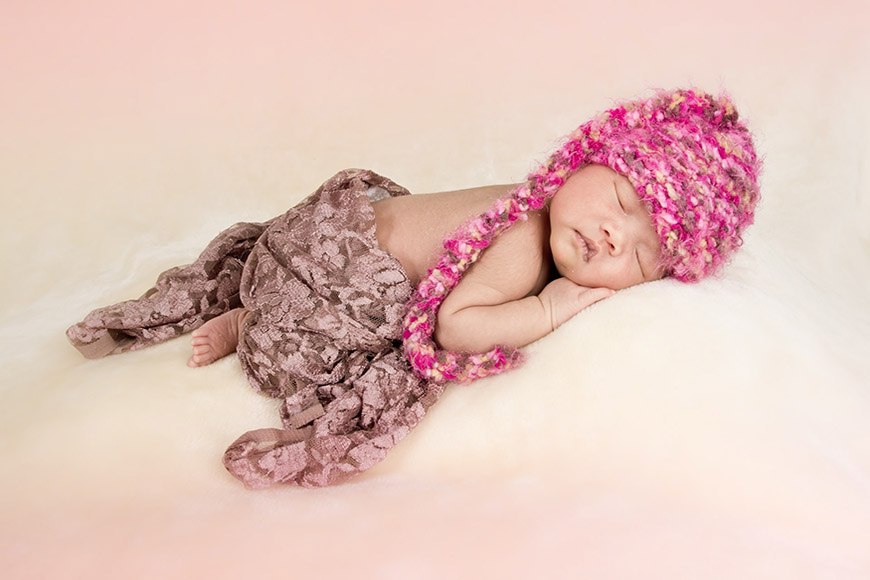
Credit: Dominic Ong
First things first – always, always, always wash your hands before handling a newborn baby – they’re so vulnerable to germs and illness, you want to be as clean as possible just in case.
And of course, if you have an illness, postpone the newborn photography session – the child’s health is the number one priority here.
This goes beyond basic newborn photoshoot tips. Health and safety are your top priority when working with any vulnerable photography subjects like newborn babies.
11. Follow the Newborn’s Lead
If the newborn baby is awake and settled, that’s when I suggest gathering all together for a group portrait. Different photographers approach family photos differently – many of them if they are more used to family photography, for example, request that the little one has an enormous feed beforehand to induce a big long sleep.
The more you photograph newborns, the more you’ll get a sense of how you want to go about this.
12. Choose the Asleep Shots Carefully
Certain newborn photography shots are easiest when the baby is asleep: close-ups of their tiny toes, for example, are much easier when their little hands and feet aren’t wriggling around. While sleeping, the baby’s hands will open, close and fingers will point. Use this opportunity to make the of this natural hand posing for a standout newborn photo.
13. Watch Your Voice
Try to keep speaking around the newborn, so they get used to your voice and it doesn’t startle them to hear a stranger so close to them. With baby photography, keep your voice low and calm; newborns are very sensitive to noise.
14. Watch for Sleeping States
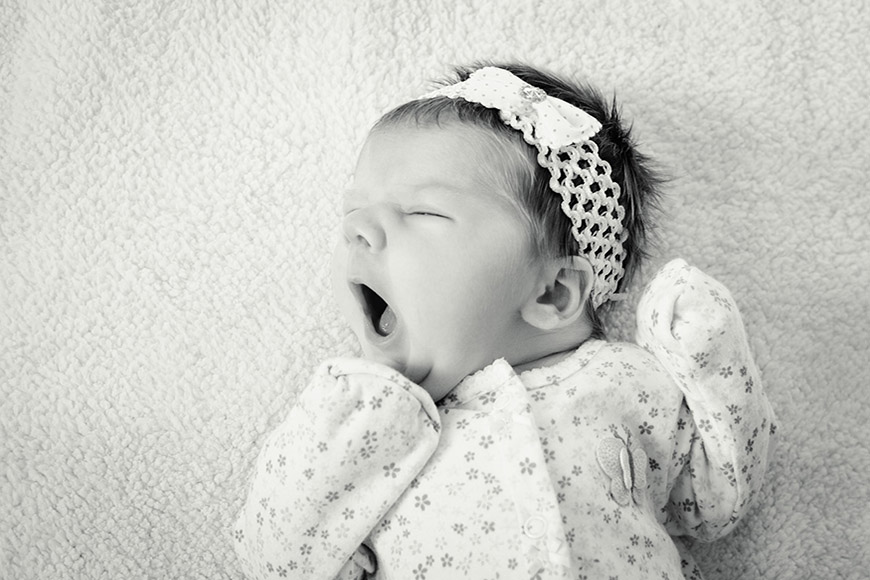
Credit: Kelly Sikkema
When an infant is starting to fall asleep, wait a minute or two so they fall asleep properly – even on silent mode, a clicking shutter can be enough to disturb that sleep.
Don’t try to move the baby until they’re in a deep sleep – when their bodies have become very still and their breathing is deeper. If you move them or try to pose them in light sleep, they’ll wake up!
15. Full Tummy
If a newborn is irritated by hunger, you’ll never get them settled – let the parents feed him/her till they’ve had enough, and you’ll have a much easier job on your hands.
If there are siblings included in family photos, consider their hunger levels too. Avoid sugary snacks as this will make them unmanageable and they’ll fidget throughout their posts.
A hungry child is just as tricky to deal with so making sure they have a good energy level will make a great deal of difference. That way the family photos you capture will capture them at their best.
16. Move Yourself First

Credit: Kelly Sikkema
Bear in mind that some newborns have a natural tendency to turn their heads more to one side than the other – it’s easier to move them around if you find they keep ending up looking away from you.
17. Warm-up
Newborn’s are also sensitive to touch, and temperature – make sure your hands are warm before you touch a newborn, or you’ll startle them and quite likely make them cry.
For studio sessions, do all possible to make the space comfortable for the babies. You’ll get your most creative baby photos when everyone, babies included, are feeling relaxed.
Well before the family arrives and you pose the baby, set up a heater to warm the studio space. Consider having warm and comfortable blankets on hand. If the baby is comfortable, the parents will relax – the parents will become your best studio assistants.
You’ll have an easier time of it and capture memorable family and baby photos.
Newborn Photography FAQ
When should newborn photos be taken?
Newborn photographer Louise Downham recommends doing it when they are 7 to 10 days old. Although, you can do it at any point during the first couple of weeks.
Is 2 weeks too old for newborn photos?
No, even if these types of photos are usually taken during the first couple of weeks, technically a child is considered a newborn up until 2 months of age. For some, it can be more comfortable to wait.
Do you use flash for newborn photography?
It’s best if you don’t use a flash for a newborn shoot. However, if you do have to use a flash, try bouncing strobes or using large diffusers when taking photos. Avoid speedlights or the pop-up flash from your camera and never fire them directly into the infant’s eyes.
Is newborn photography safe?
Photography for newborn babies is safe. But, you need to use appropriate equipment and props, always take care of the infant’s comfort and safety, and never use strong flashes directly. As a photographer, you need to make safety your number one priority. And remember, when setting up newborn poses, always support the baby’s head.
What are some photo ideas for a 6-month birthday photoshoot?
Newborn Photography | Final Words
This area of photography is profitable and rewarding, but newborn photography can be tricky if you’re not prepared. Remember that it’s also a new experience for your client, so make sure that you keep them informed.
As a newborn baby photographer, your job is not just to take photos. You have to provide guidance and direction before and during the entire session. Newborn baby photography can be stressful for new parents even if they’ve had family photos for older siblings.
Our pro tip; your role as the photographer is to focus on more than just the final photo. Good luck!
An email that tells them what they need and what to expect can go a long way, and once they see your beautiful images, they will become your best marketers, and perhaps introduce you to your next maternity photography client, who’ll eventually become your next newborn client ;-)
I hope this article was helpful to improve your baby photography. If you have any doubts or some more advice, please share it in the comments section.

Check out these 8 essential tools to help you succeed as a professional photographer.
Includes limited-time discounts.
Louise Downham is an award winning family portrait photographer based in London.






